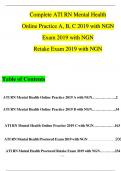Resumen
TUSSENTOETS en EINDTOETS: College Aantekeningen en Boek Samenvattingen - Hersenen En Gedrag () - Custom Brain and Behaviour + MindTap, ISBN: 9781473769762
- Grado
- Institución
- Book
Dit document bevat alle inhoud van alle slides van alle hoorcolleges, alle aantekeningen van alle hoorcolleges, en samenvattingen van hoofdstuk 1, 2, 3, 4, 7, 8, 10, 11, 13, 14, en 16.
[Mostrar más]













